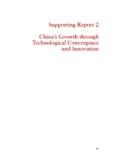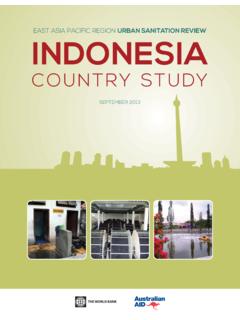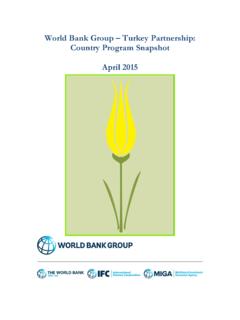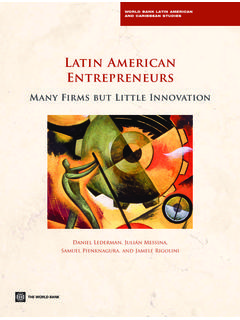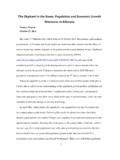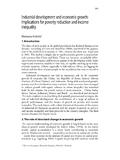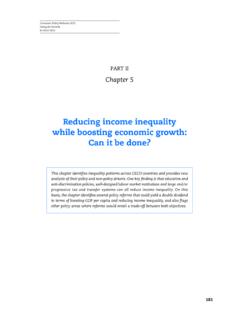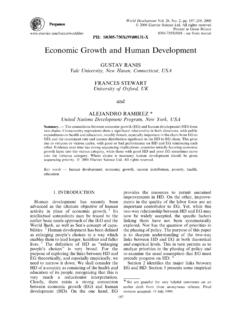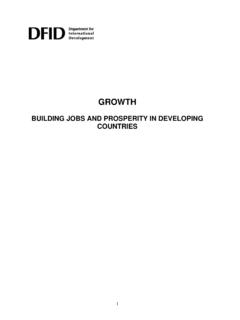Transcription of OPEN DATA FOR ECONOMIC GROWTH - World …
1 1 open data FOR ECONOMIC GROWTH June 25, 2014 Transport & ICT Global Practice 2 Table of Contents Acknowledgments: .. 3 Summary .. 4 Introduction .. 4 The Size of the Potential Prize .. 5 Unique Characteristics and Challenges .. 8 What data is most important for ECONOMIC GROWTH .. 10 open data Companies .. 10 Types of Businesses .. 12 Policy Implications .. 14 Conclusion .. 20 3 Acknowledgments: This report was prepared by Andrew Stott, Senior open data Consultant, World Bank. Thanks to colleagues within the World Bank and external experts who have contributed to and commented on this paper in draft, as well as to the original research by McKinsey, Deloitte, the EU and others cited in the report. Standard Disclaimer: This volume is a product of the staff of the International Bank for Reconstruction and Development/ The World Bank.
2 The findings, interpretations, and conclusions expressed in this paper do not necessarily reflect the views of the Executive Directors of The World Bank or the governments they represent. The World Bank does not guarantee the accuracy of the data included in this work. Copyright Statement: This report, created by The World Bank, is available under the Creative Commons Attribution Unported ( ) license. 4 Summary 1. Many governments are pursuing open data policies. One of the key policy drivers has been to use open data to drive ECONOMIC GROWTH and business innovation. This paper examines the evidence for the ECONOMIC potential of open data and concludes that, despite a variation in published estimates and some methodological difficulties, the potential is very large indeed.
3 It reviews the latest data about companies using open data , and highlights four companies which did not exist ten years ago, which are driven by open data , and which are each now valued at around $1 billion or more. It discusses the five archetypical types of businesses using open data , and cites concrete examples of each, and discusses the types of data which are proving most likely to lead to widespread business adoption and innovation. It suggests that governments should see themselves not only as a Supplier of open data but also as a Leader, Catalyst and User of it. Finally it makes some recommendations for policies and actions which governments could take to maximise the ECONOMIC GROWTH possible from their data . Introduction 2. Governments collect or generate a lot of data for their own purposes or from their own operations.
4 A priori the collection and generation of this data is justified by the benefits of the use of this data within governments for the purposes for which it was collected. The benefits may be financial, for instance in terms of policy making, resource allocation or operational management and optimisation; or they may be non-financial, for instance in meeting legislative and other requirements for transparency and accountability. In principle if governments did not gain a net benefit from collecting and using the data then they would not collect it in the first place. 3. Governments may also collect data which is not of direct benefit to government itself but in order to provide wider ECONOMIC and social benefits. For instance cadastral information contributes to an authoritative system of land ownership and proof of title, which has important ECONOMIC benefits.
5 In some cases the provision of information is a natural monopoly and the government collects it as the best-placed actor to do so - for instance the Danish government intervened to create a single, accurate, national address register for all sectors of the economy - including the public services themselves1. 4. However because use of data is non-rivalrous the fact that governments (or others) have used the data for the purpose for which it was originally collected does not prevent that data being used for other purposes - by others or, indeed, by other 1 5 parts of the government itself. ECONOMIC theory suggests2 that benefits are maximised when access to the information is priced at the marginal cost of distribution - and the internet has made the marginal cost of distribution of digitised data by download from the web effectively zero.
6 While there may be distribution costs such as setting up an open data portal and policy and technical work to implement the extraction data from internal databases, these are mainly one-off expenditures which are usually infeasible or uneconomic to amortise in recurrent charges for data access - the amounts involved are typically small compared to the on-going costs payment collection and administration that would be necessary to recover them. 5. So many governments have now launched open data programmes to make their digital, machine-readable data available to business and citizens to use and reuse free of charge for any lawful purpose. For most governments the policy objectives have been a mixture of four distinct drivers: ECONOMIC GROWTH , including business innovation and the creation of companies and jobs; closer and more inclusive citizen engagement in improving public services, particularly by giving citizens information on standards of provision and service performance which equips them to be more engaged consumers of public services; increased transparency and accountability; and improvement in the efficiency and operations of public services themselves, for instance through better decision-making through access to data from other agencies.
7 6. For the citizen engagement, transparency and efficiency objectives open data has assisted and enhanced civic and governmental processes already underway. However the release for the first time of government data has created completely new opportunities for the opportunities for ECONOMIC GROWTH , innovation and jobs - both in the creation of ECONOMIC activity in new, data -rich services themselves and in the wider ECONOMIC benefits of the use of these services by others in the business and personal sectors. The Size of the Potential Prize 7. open data is a relatively new concept in its current, recognisable, form, dating from 2006-07 - although in some sectors and in some countries there were earlier developments which would now be seen as open Data3.
8 Even in countries which started relatively early to release government information as open data the benefits still appear to be developing. Like other innovations, it is likely to be many years until there is full adoption and the implications for downstream users have been fully understood. Indeed, as discussed later in this paper, the usage of open data 2 See for instance Pollock et al Models of Public Sector Information Provision 2008 3 See for instance Weiss 2003 6 depends not only on the availability of the data itself but also on the ideas of how to use it, and the tools to use it effectively. 8. However various policy-makers have commissioned studies of the potential ECONOMIC benefits of open data as an evidence base for decisions which need to be taken now in order to take the initial step of releasing data on open terms.
9 9. The European Commission commissioned two studies4 as the evidence base for their proposals to amend the EU Reuse of Public Sector Information Directive. The POPSIS study looked at some case studies where previously restricted data had been made open , and showed a consistent pattern of much greater usage as a result. The second study, by Graham Vickery of Information Economics, reviewed the evidence from studies on public sector information re-use as a whole and other market developments related to data . The Vickery study found that the size of the narrowly defined EU direct, business as usual , public sector information reuse market was of the order of 28 billion Euro in 2008 with an annual GROWTH rate of around 7%. However this excluded domains where re-use was not a principal activity and the value of government activities.
10 In addition it was expected that open public sector information policies, easier access to information and the abolition of charging would further stimulate the market, with direct public sector information use and re-use activities increasing to 40 billion Euro a year. 10. Importantly the Vickery study also investigated the indirect benefits of open data - for instance the additional benefit to the personal or business customers of using the services provided by the direct re-users. In total, and with easier access, improved infrastructure and lower barriers, aggregate direct and indirect ECONOMIC benefits for the whole EU economy could have been of the order of 200 billion Euro in 2008 - of the GDP of the EU as a whole. 11. More recently McKinsey5 have claimed that, globally, seven sectors6 alone could generate more than $3 trillion a year - and perhaps as much as $5 trillion a year - in additional value as a result of open data .
